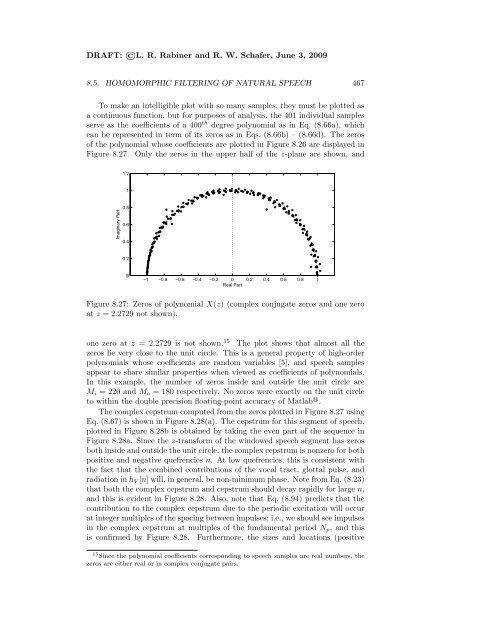LR Rabiner and RW Schafer, June 3
LR Rabiner and RW Schafer, June 3
LR Rabiner and RW Schafer, June 3
You also want an ePaper? Increase the reach of your titles
YUMPU automatically turns print PDFs into web optimized ePapers that Google loves.
DRAFT: L. R. <strong>Rabiner</strong> <strong>and</strong> R. W. <strong>Schafer</strong>, <strong>June</strong> 3, 2009<br />
8.5. HOMOMORPHIC FILTERING OF NATURAL SPEECH 467<br />
To make an intelligible plot with so many samples, they must be plotted as<br />
a continuous function, but for purposes of analysis, the 401 individual samples<br />
serve as the coefficients of a 400 th degree polynomial as in Eq. (8.66a), which<br />
can be represented in term of its zeros as in Eqs. (8.66b) – (8.66d). The zeros<br />
of the polynomial whose coefficients are plotted in Figure 8.26 are displayed in<br />
Figure 8.27. Only the zeros in the upper half of the z-plane are shown, <strong>and</strong><br />
Imaginary Part<br />
1.2<br />
1<br />
0.8<br />
0.6<br />
0.4<br />
0.2<br />
0<br />
−1 −0.8 −0.6 −0.4 −0.2 0<br />
Real Part<br />
0.2 0.4 0.6 0.8 1<br />
Figure 8.27: Zeros of polynomial X(z) (complex conjugate zeros <strong>and</strong> one zero<br />
at z = 2.2729 not shown).<br />
one zero at z = 2.2729 is not shown. 15 The plot shows that almost all the<br />
zeros lie very close to the unit circle. This is a general property of high-order<br />
polynomials whose coefficients are r<strong>and</strong>om variables [5], <strong>and</strong> speech samples<br />
appear to share similar properties when viewed as coefficients of polynomials.<br />
In this example, the number of zeros inside <strong>and</strong> outside the unit circle are<br />
Mi = 220 <strong>and</strong> Mo = 180 respectively. No zeros were exactly on the unit circle<br />
to within the double precision floating-point accuracy of Matlab .<br />
The complex cepstrum computed from the zeros plotted in Figure 8.27 using<br />
Eq. (8.67) is shown in Figure 8.28(a). The cepstrum for this segment of speech,<br />
plotted in Figure 8.28b is obtained by taking the even part of the sequence in<br />
Figure 8.28a. Since the z-transform of the windowed speech segment has zeros<br />
both inside <strong>and</strong> outside the unit circle, the complex cepstrum is nonzero for both<br />
positive <strong>and</strong> negative quefrencies n. At low quefrencies, this is consistent with<br />
the fact that the combined contributions of the vocal tract, glottal pulse, <strong>and</strong><br />
radiation in hV [n] will, in general, be non-minimum phase. Note from Eq. (8.23)<br />
that both the complex cepstrum <strong>and</strong> cepstrum should decay rapidly for large n,<br />
<strong>and</strong> this is evident in Figure 8.28. Also, note that Eq. (8.94) predicts that the<br />
contribution to the complex cepstrum due to the periodic excitation will occur<br />
at integer multiples of the spacing between impulses; i.e., we should see impulses<br />
in the complex cepstrum at multiples of the fundamental period Np, <strong>and</strong> this<br />
is confirmed by Figure 8.28. Furthermore, the sizes <strong>and</strong> locations (positive<br />
15 Since the polynomial coefficients corresponding to speech samples are real numbers, the<br />
zeros are either real or in complex conjugate pairs.
















